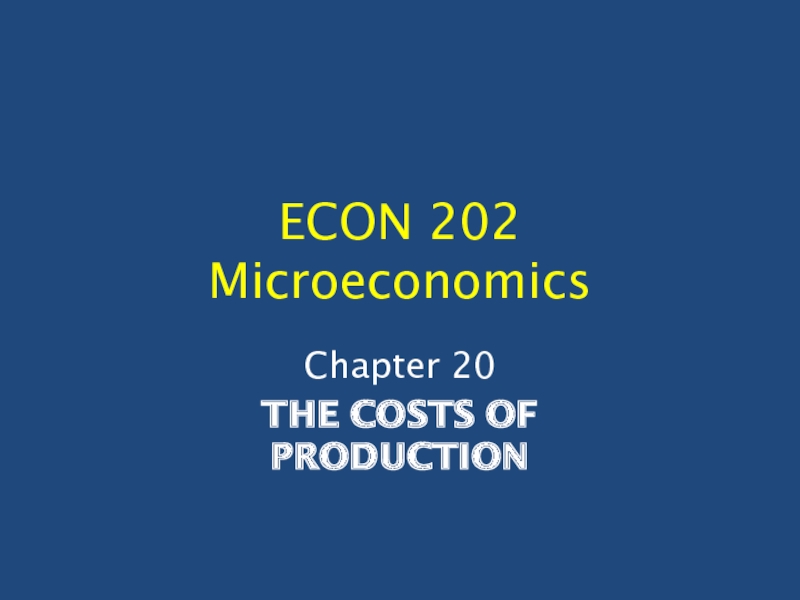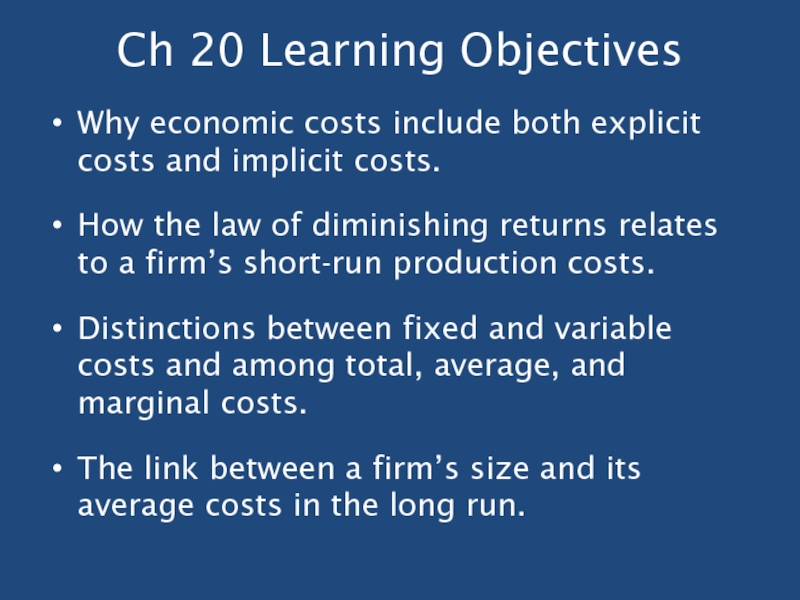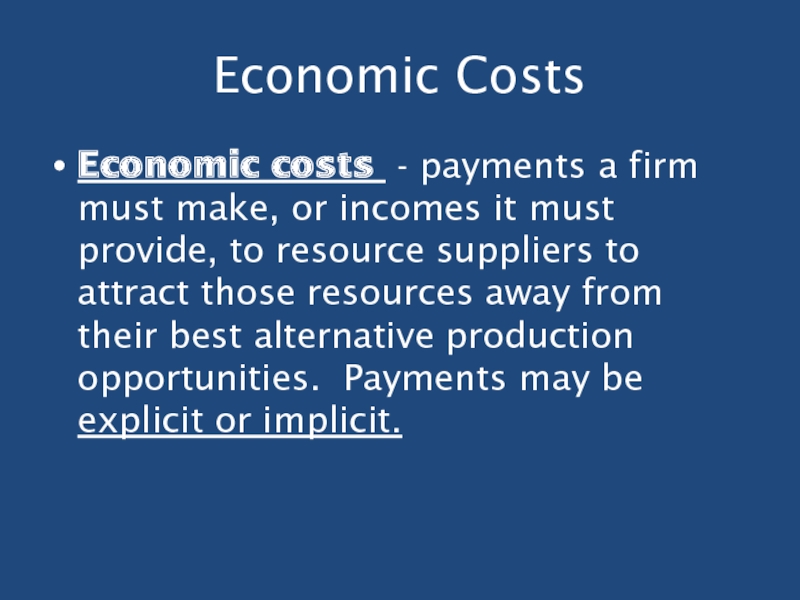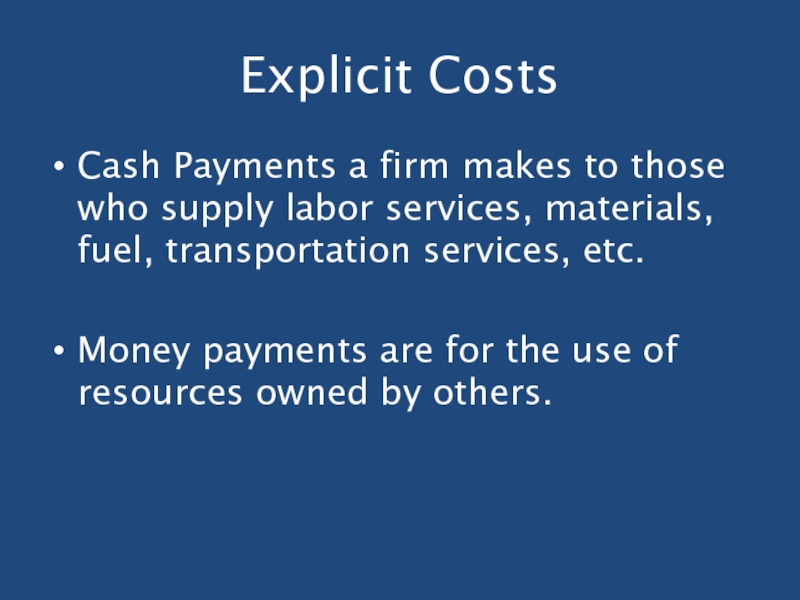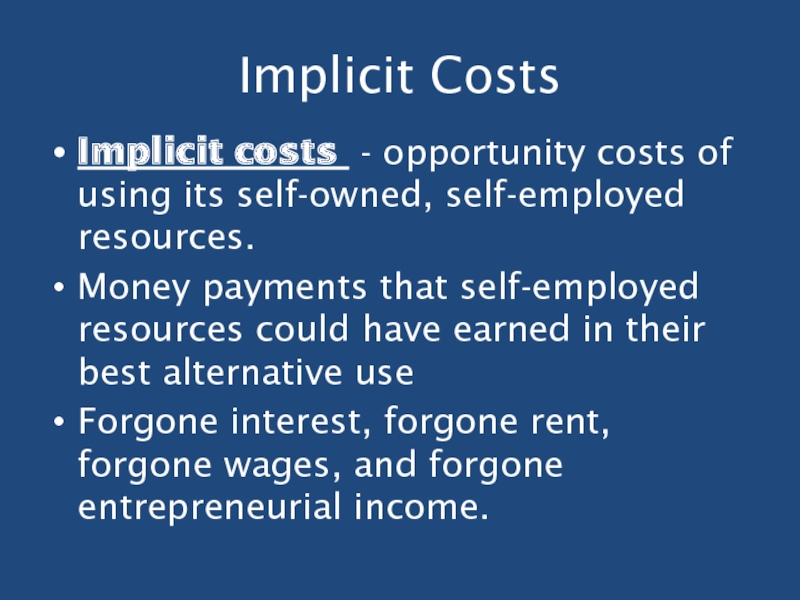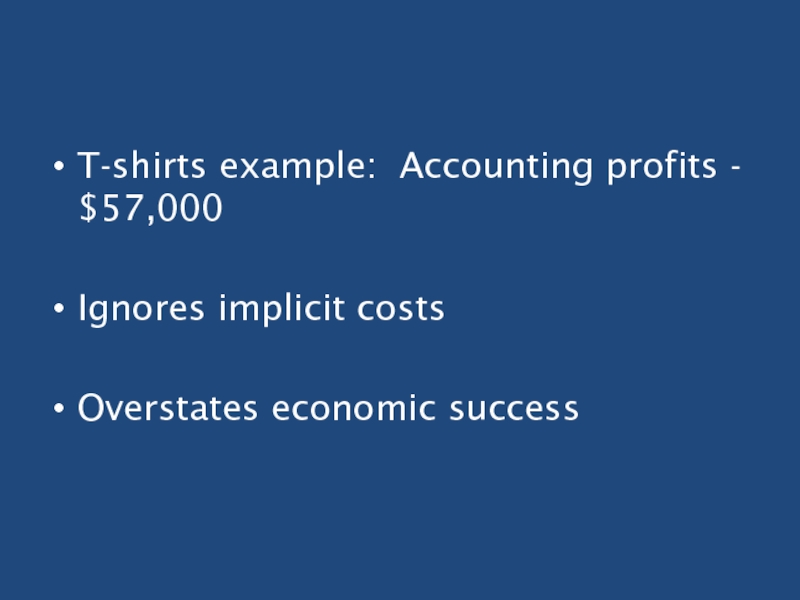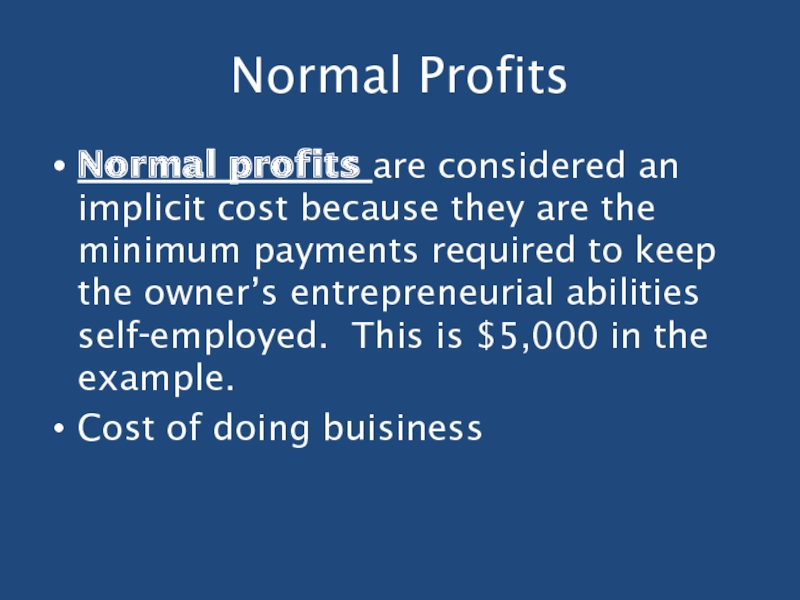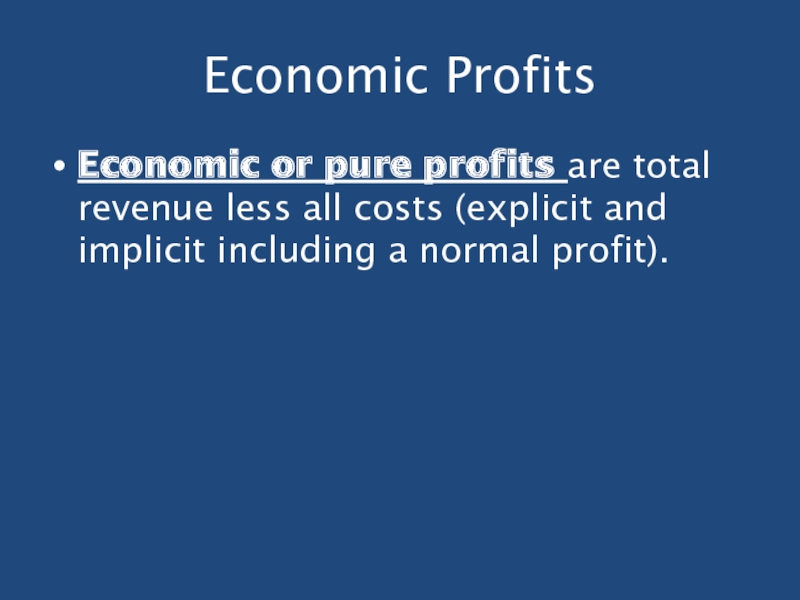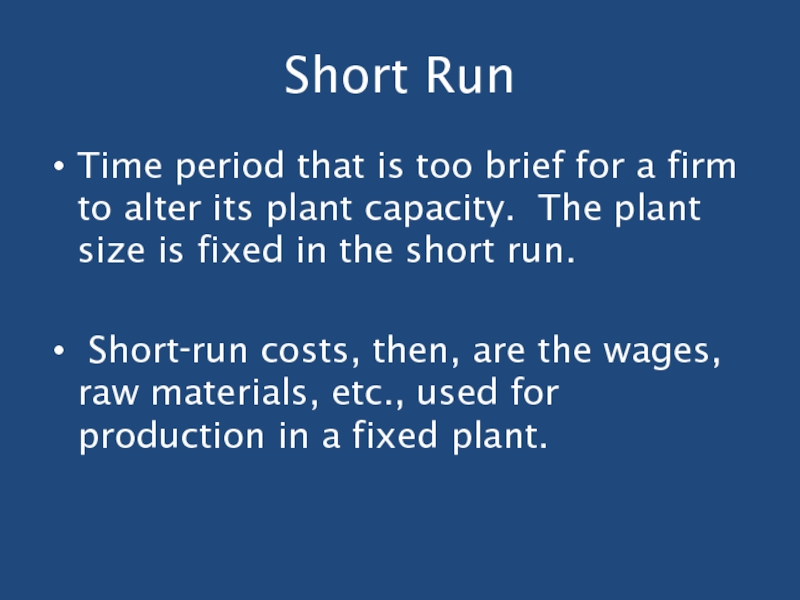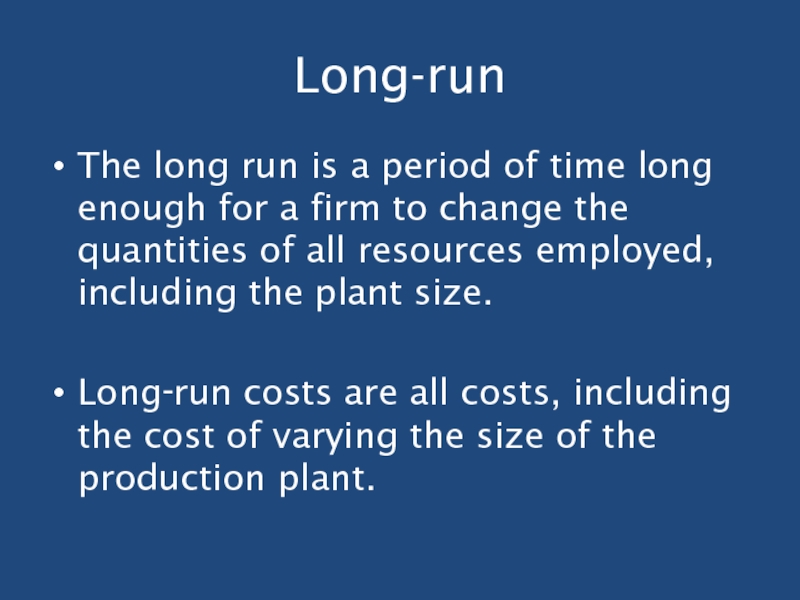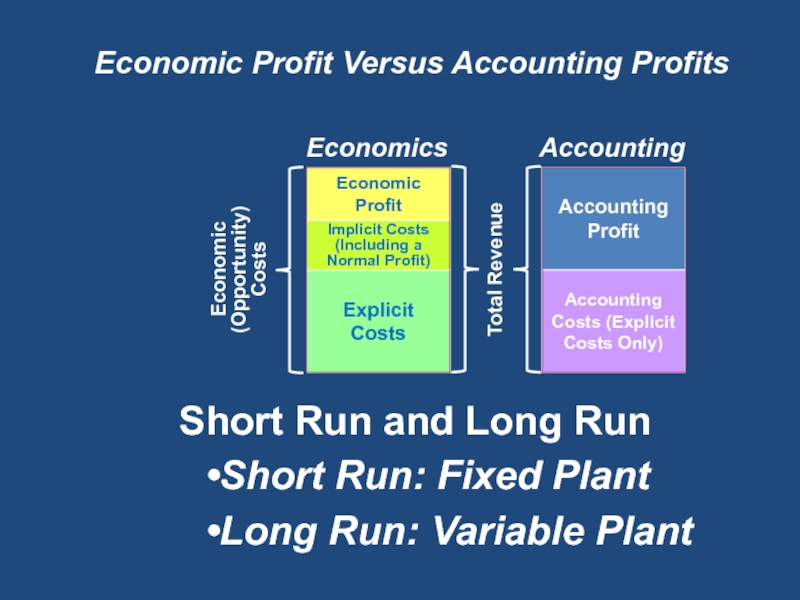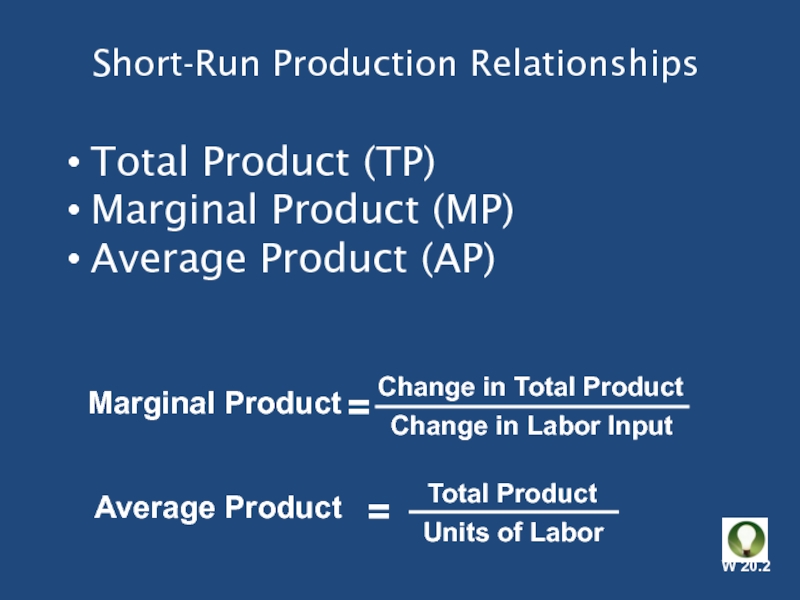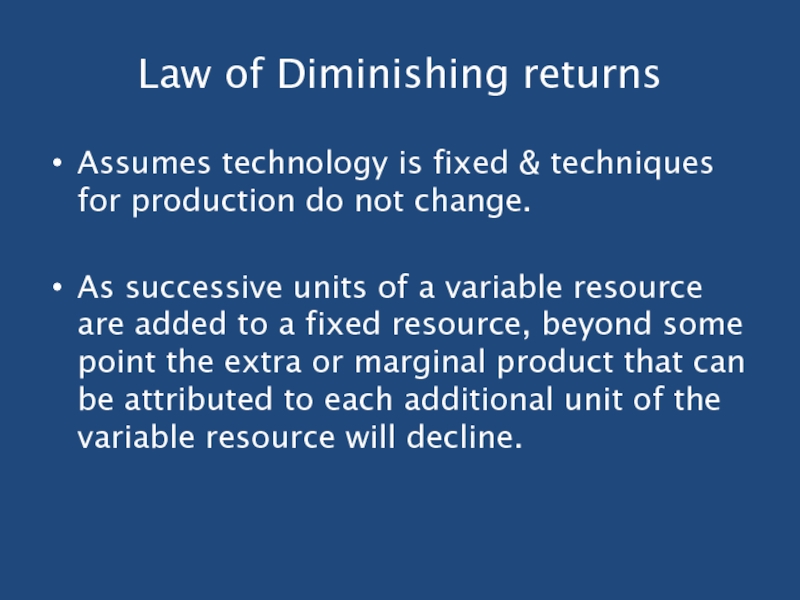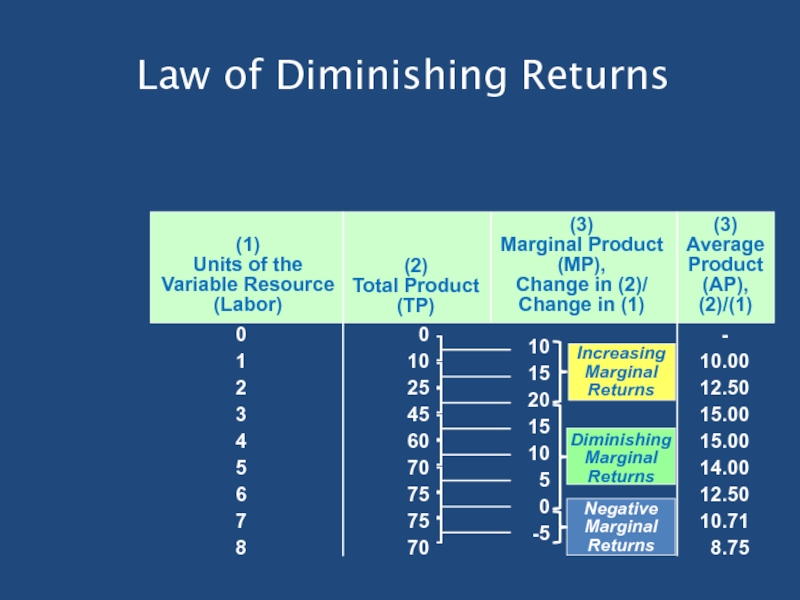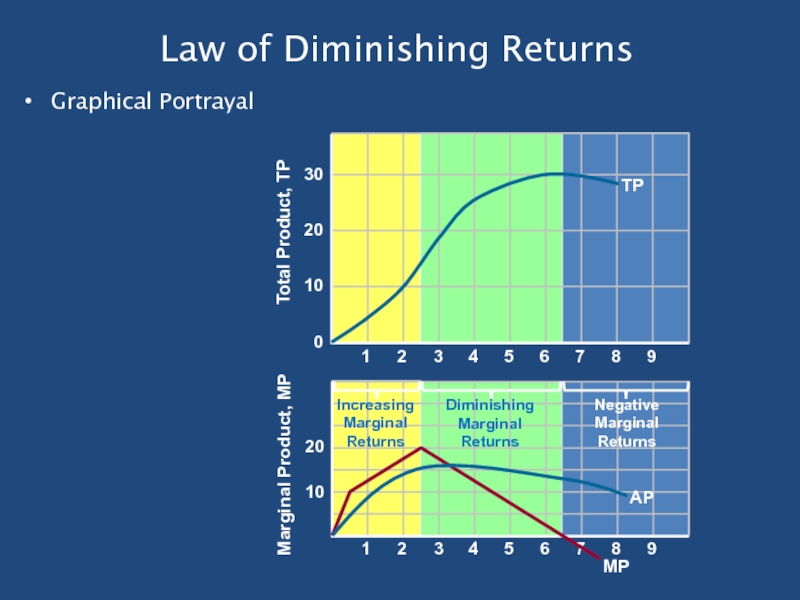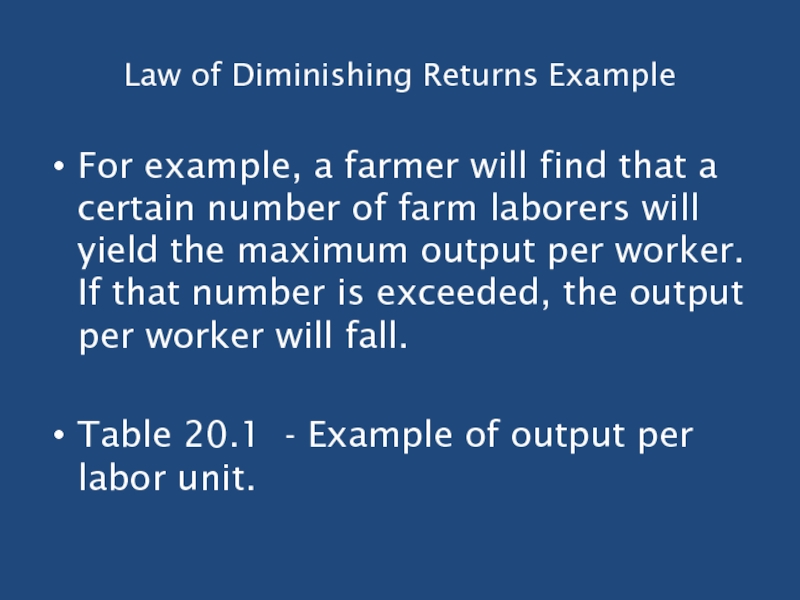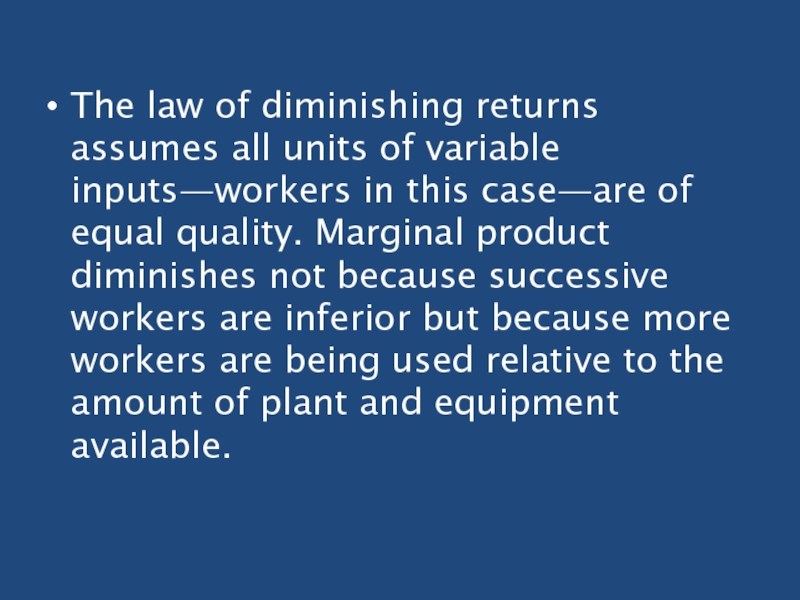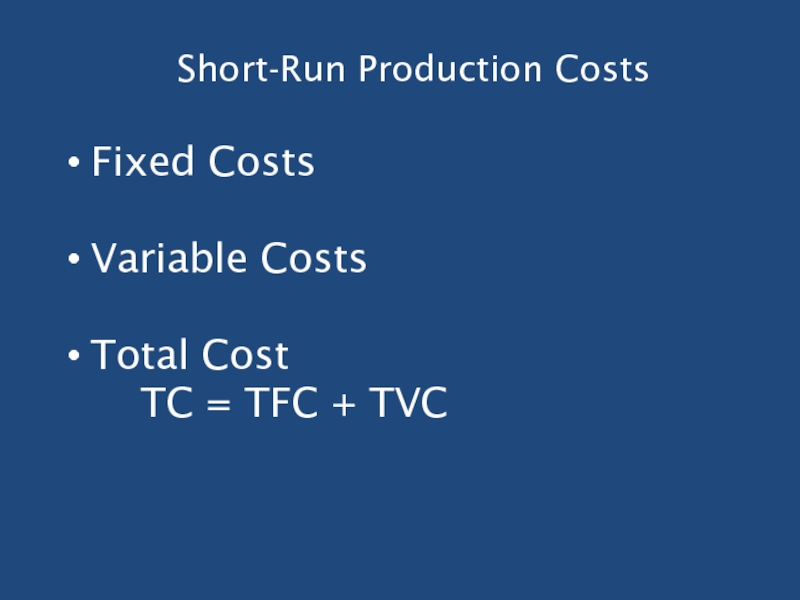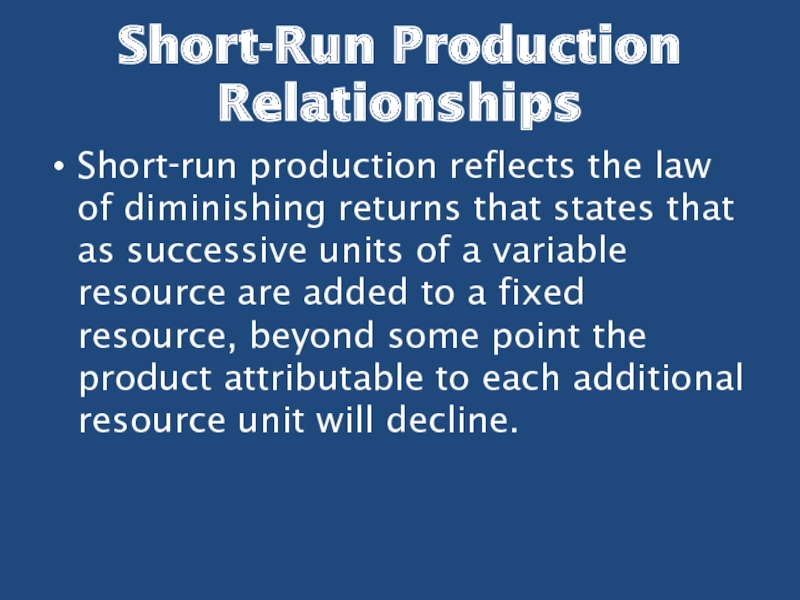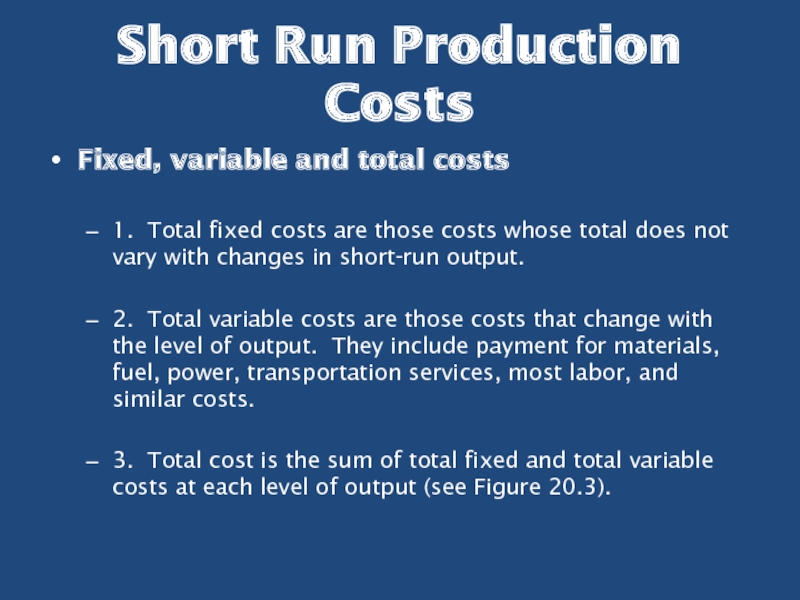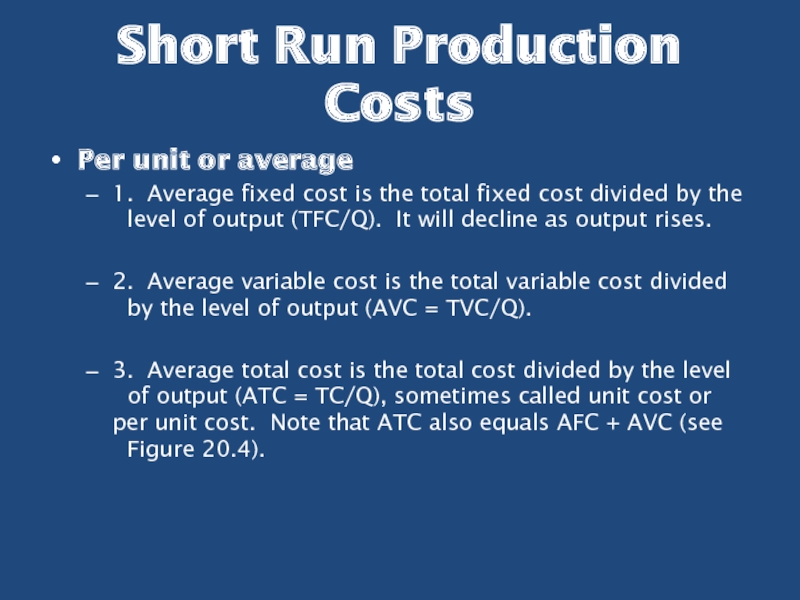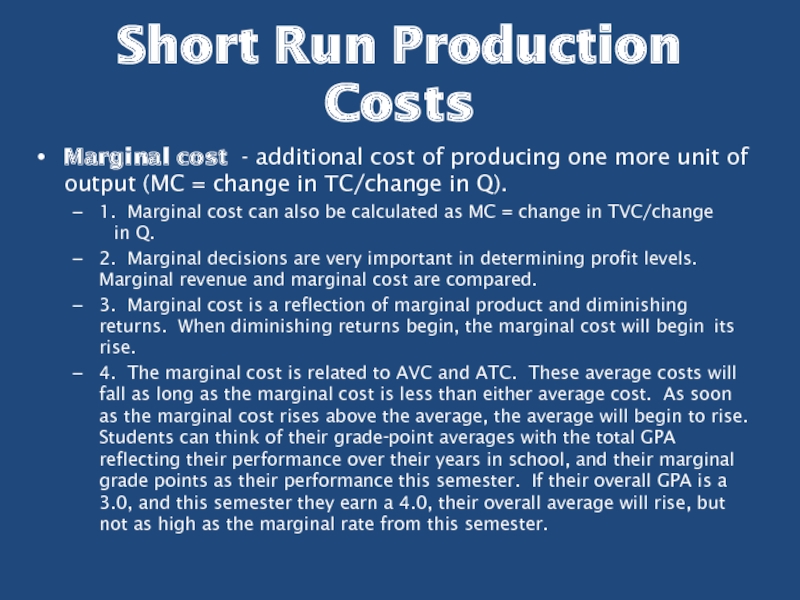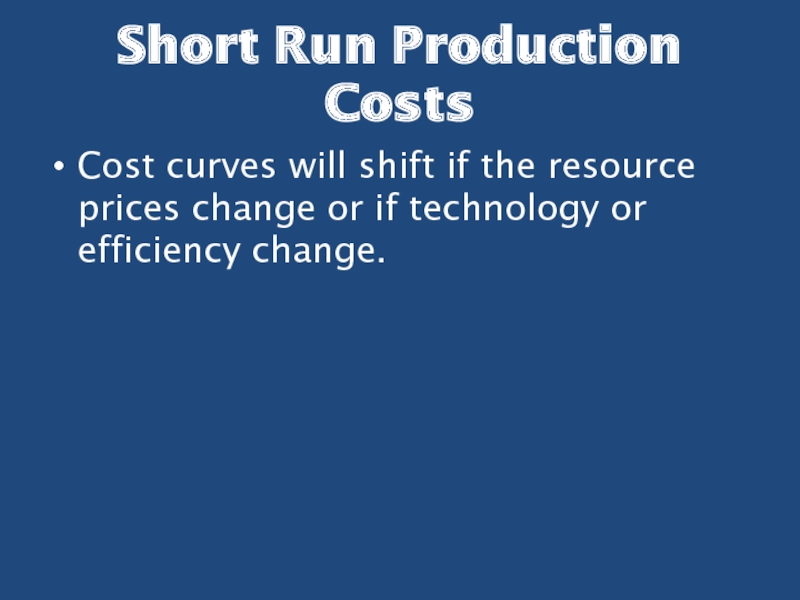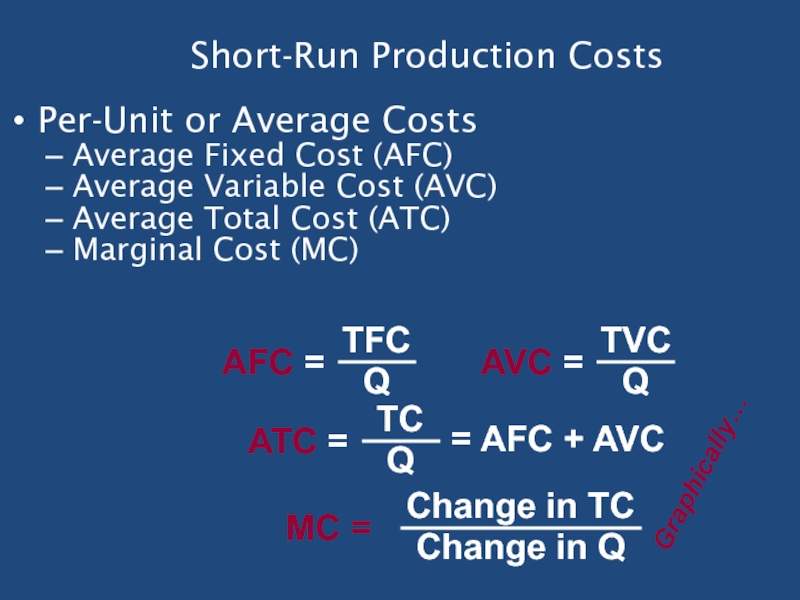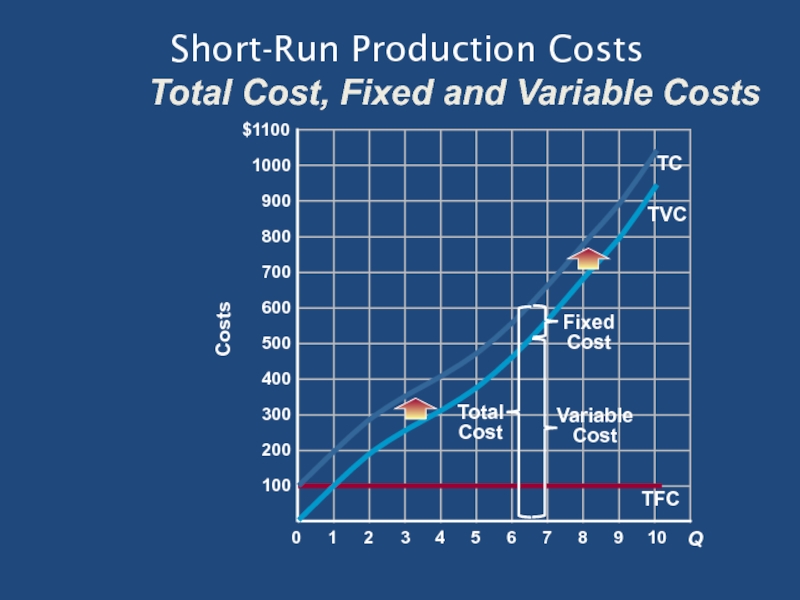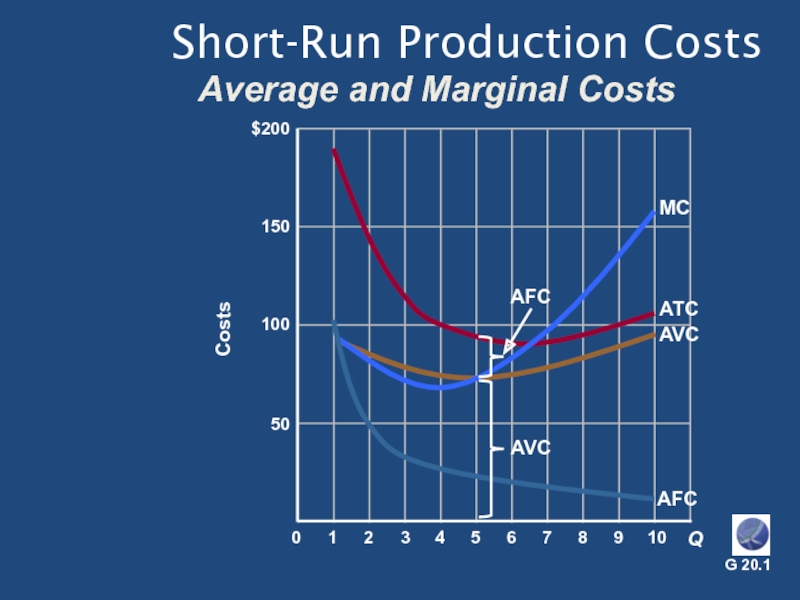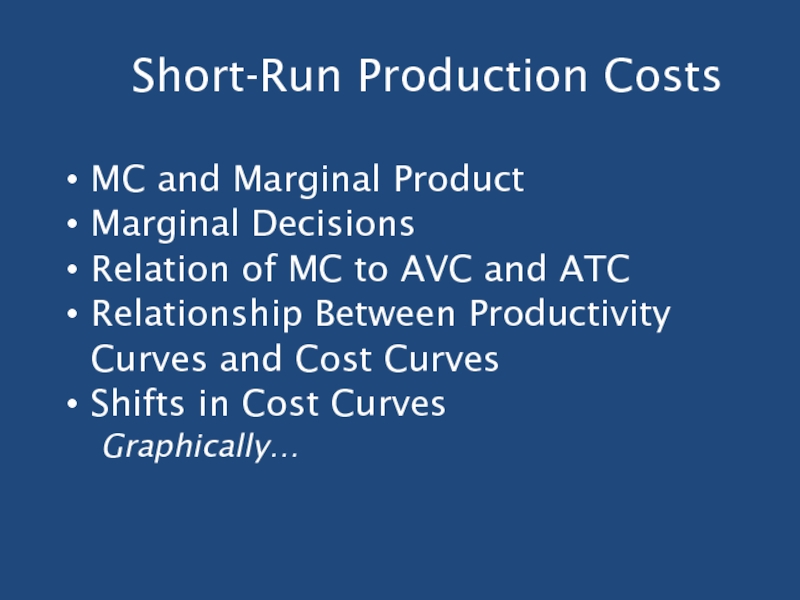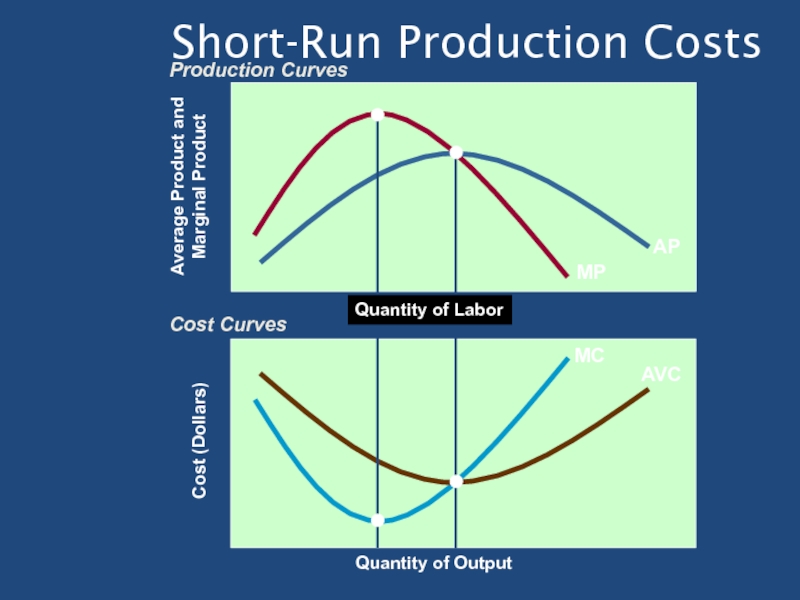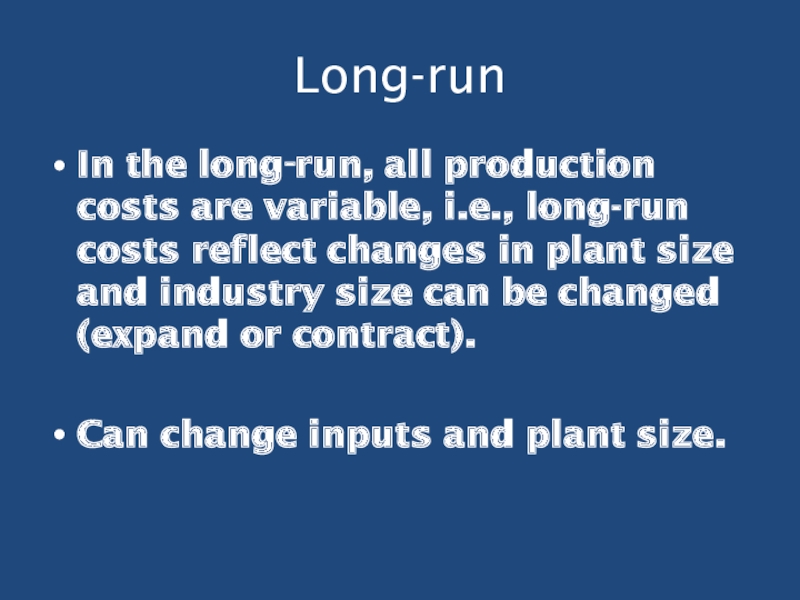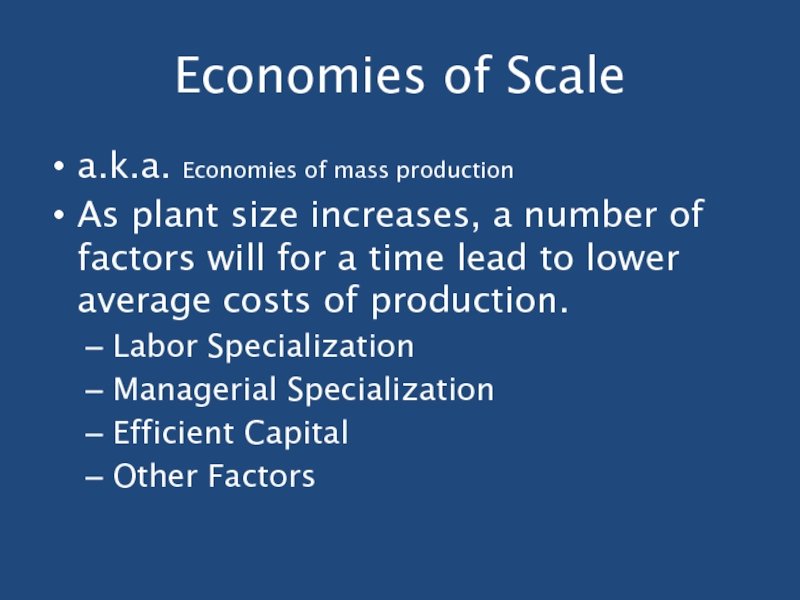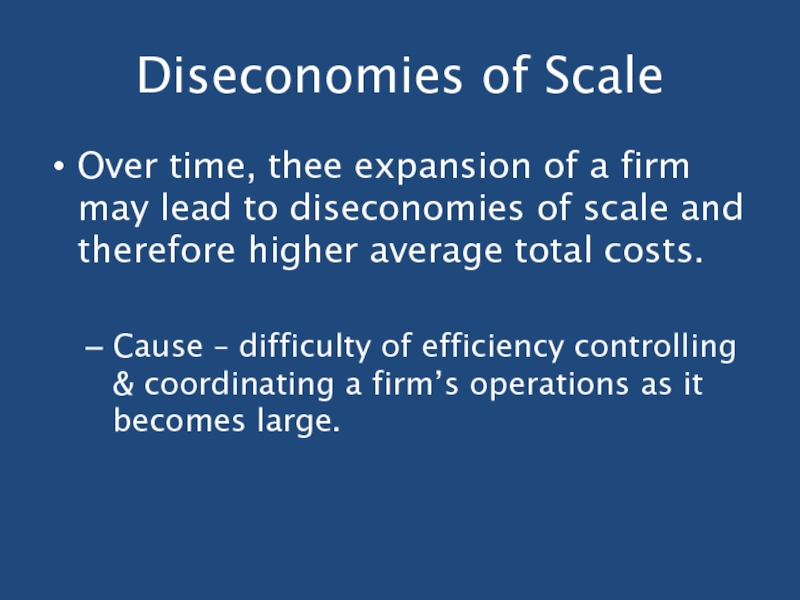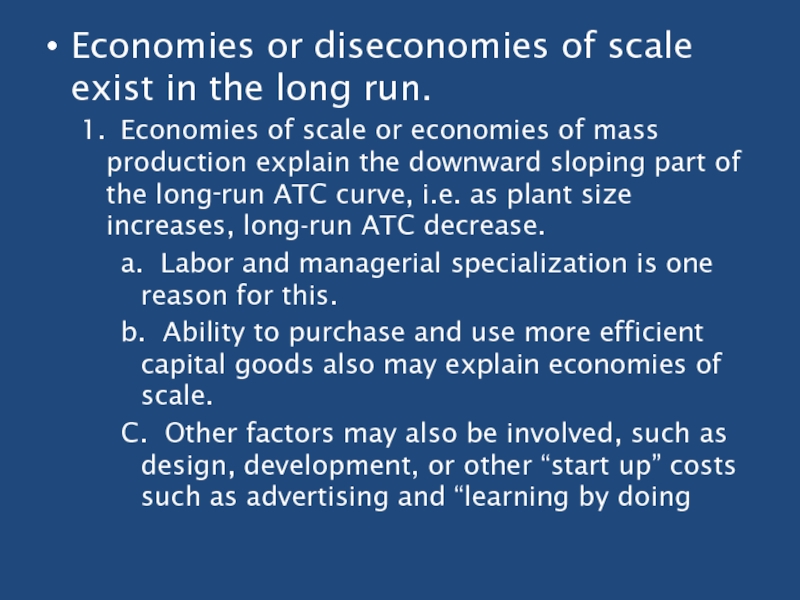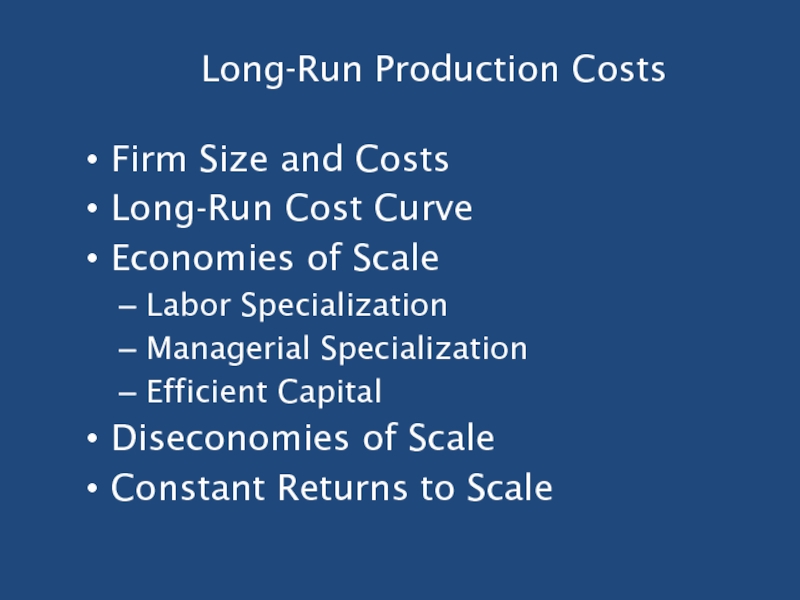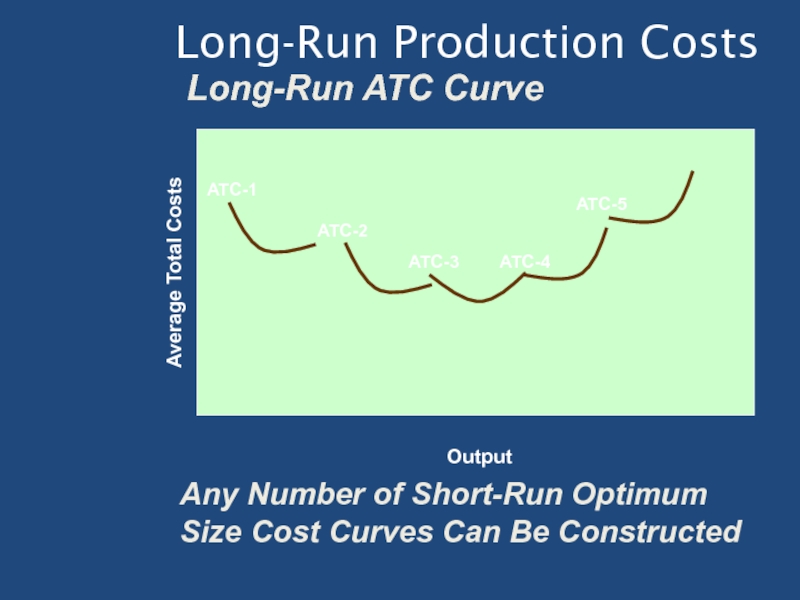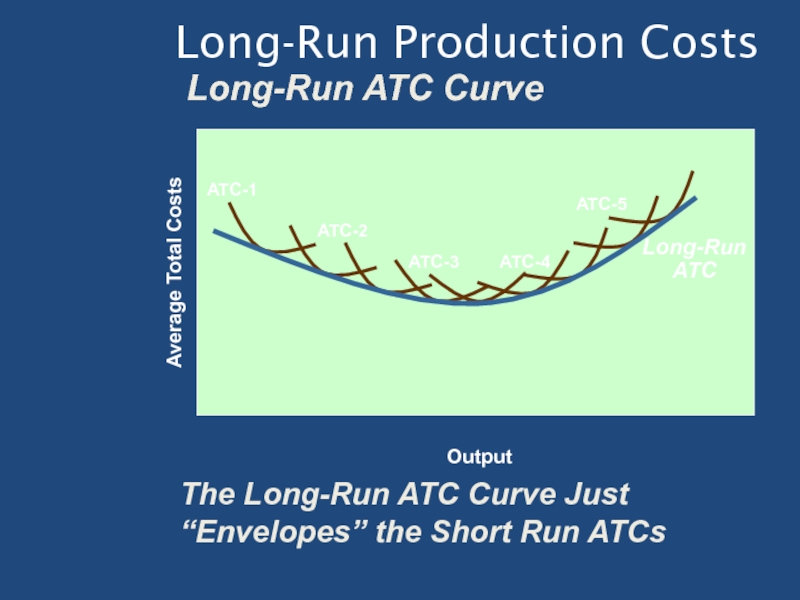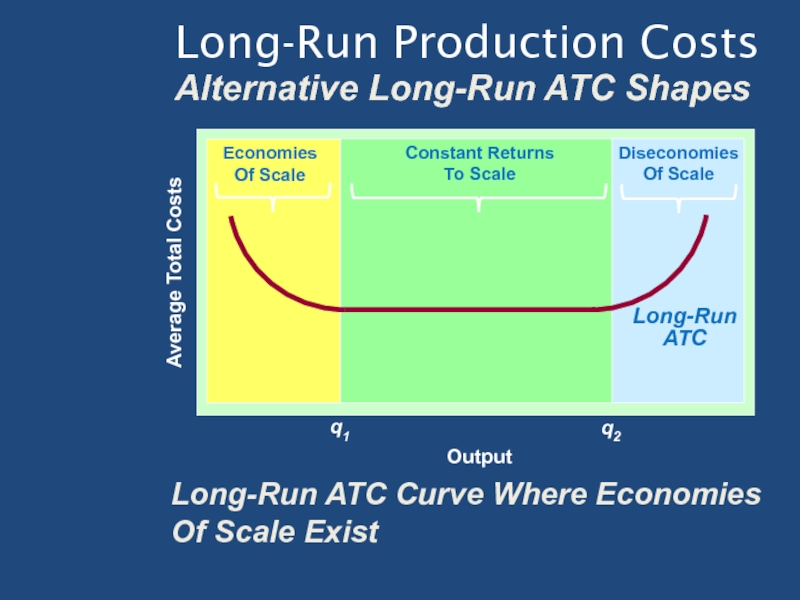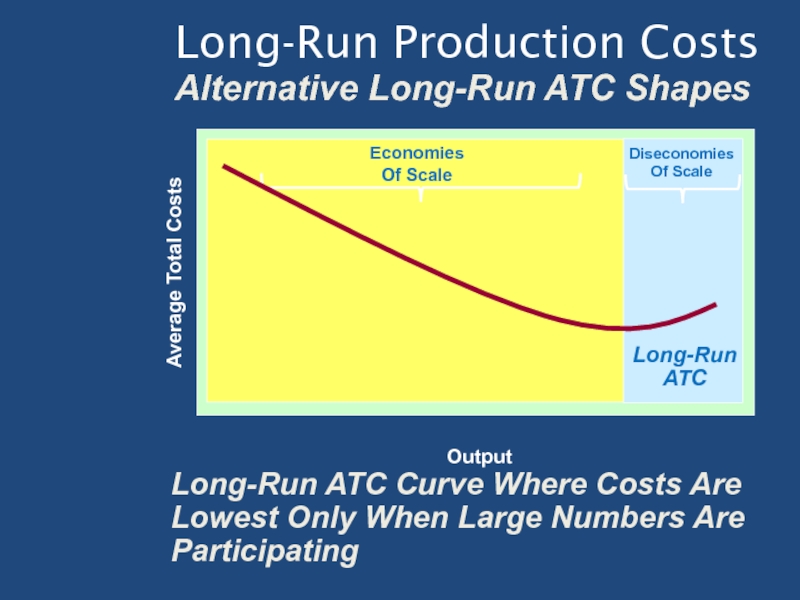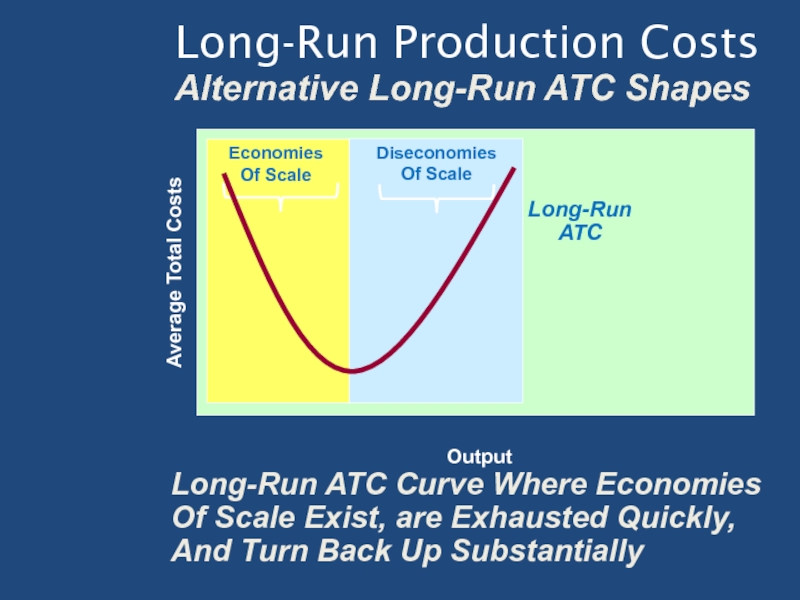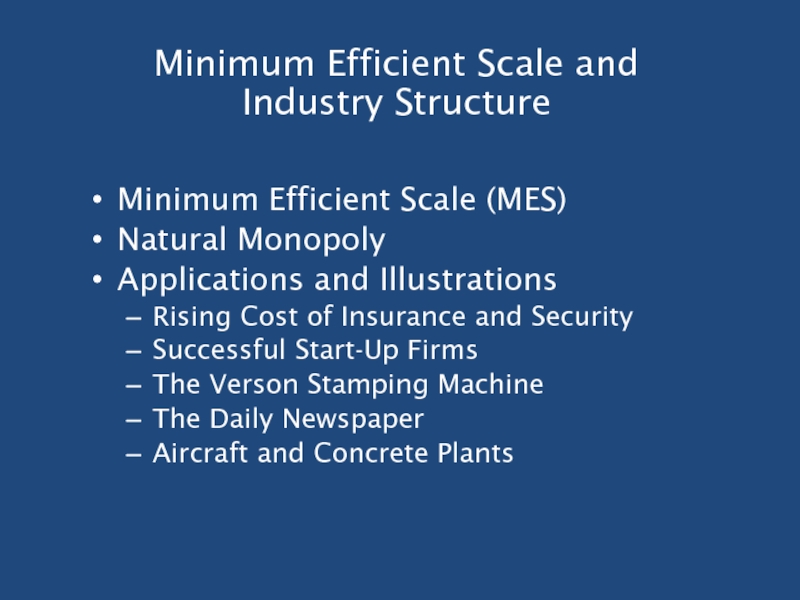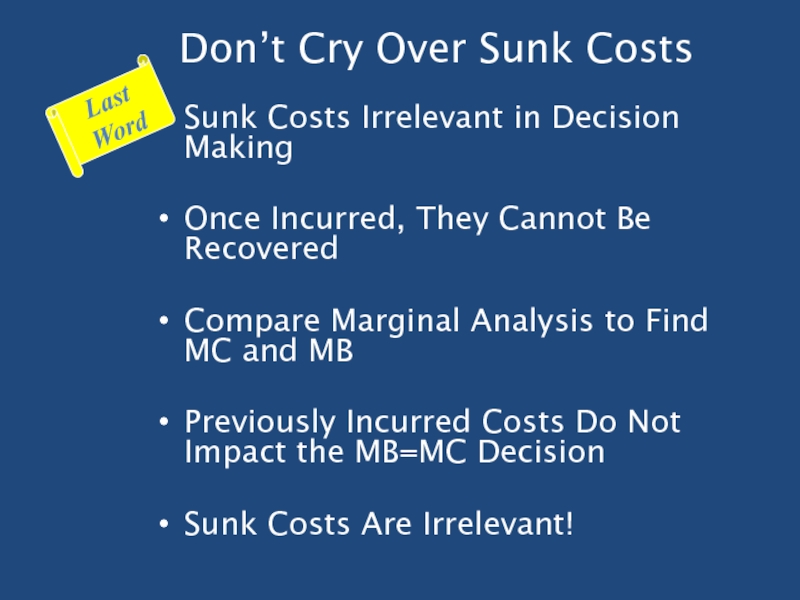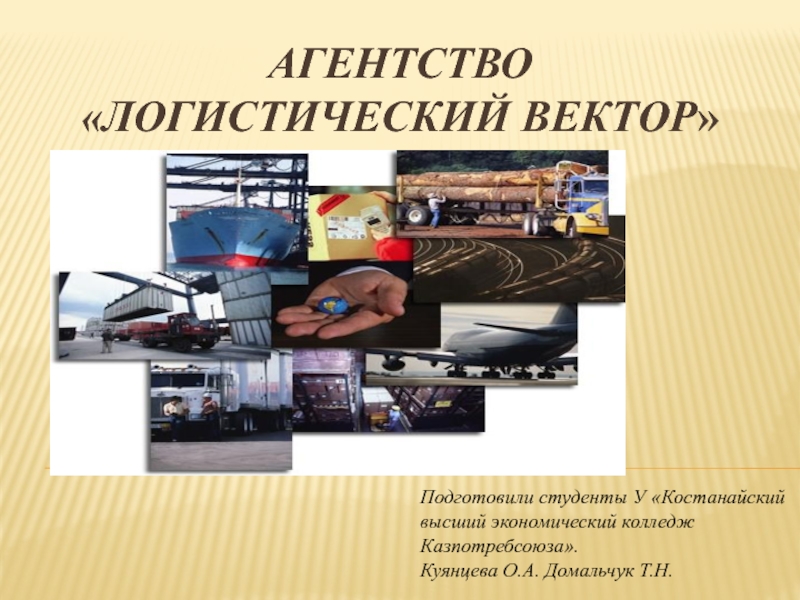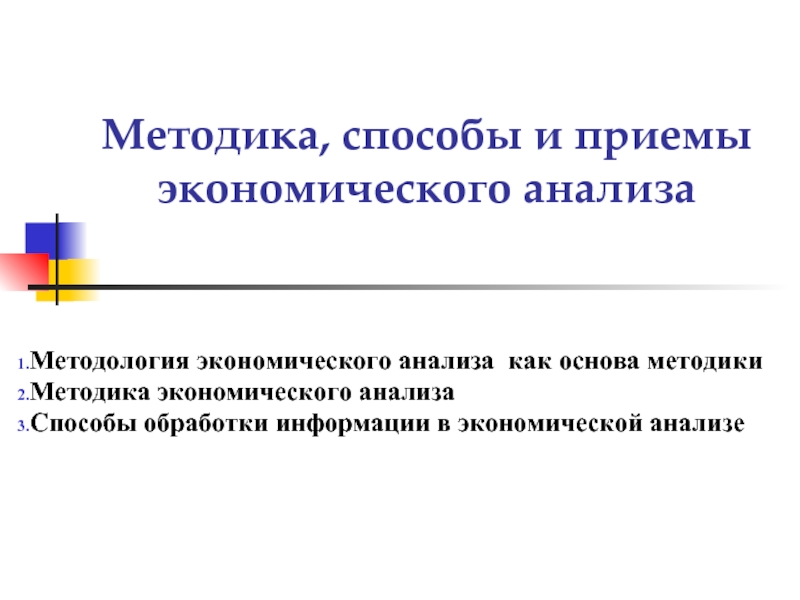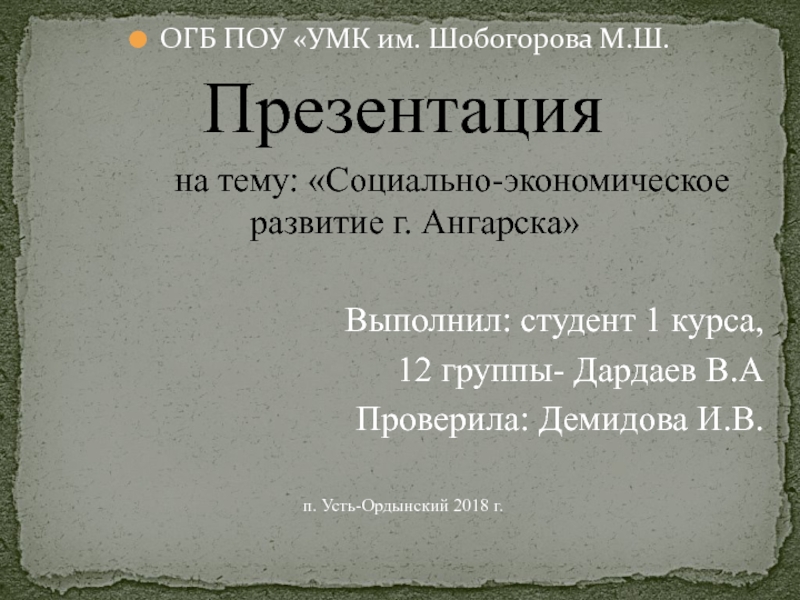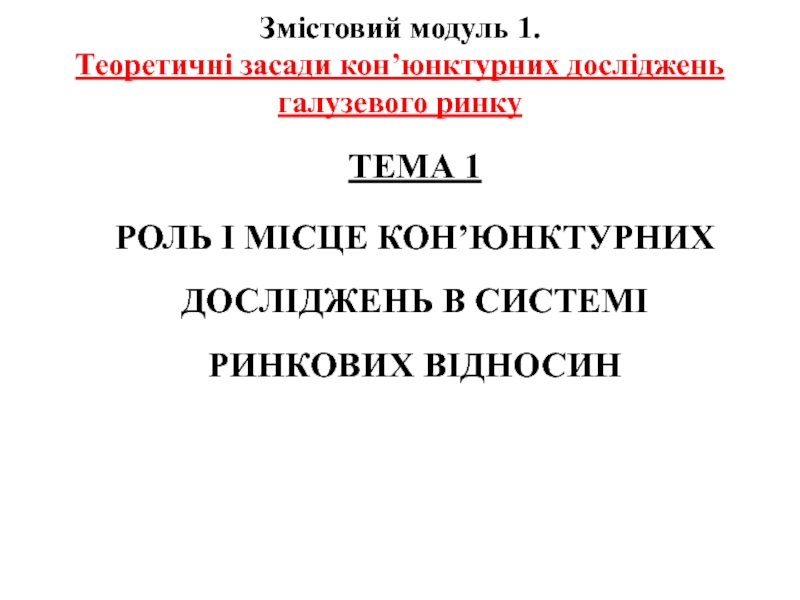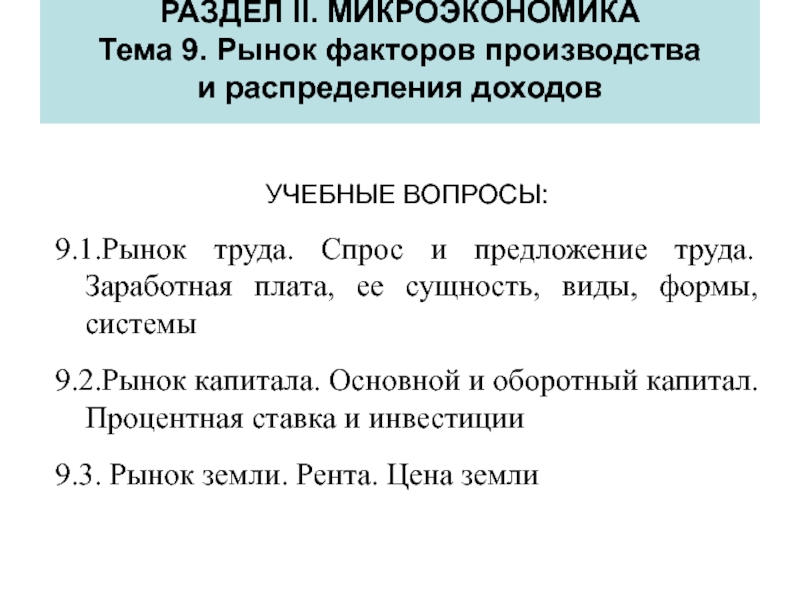- Главная
- Разное
- Дизайн
- Бизнес и предпринимательство
- Аналитика
- Образование
- Развлечения
- Красота и здоровье
- Финансы
- Государство
- Путешествия
- Спорт
- Недвижимость
- Армия
- Графика
- Культурология
- Еда и кулинария
- Лингвистика
- Английский язык
- Астрономия
- Алгебра
- Биология
- География
- Детские презентации
- Информатика
- История
- Литература
- Маркетинг
- Математика
- Медицина
- Менеджмент
- Музыка
- МХК
- Немецкий язык
- ОБЖ
- Обществознание
- Окружающий мир
- Педагогика
- Русский язык
- Технология
- Физика
- Философия
- Химия
- Шаблоны, картинки для презентаций
- Экология
- Экономика
- Юриспруденция
Microeconomics. The costs of production. Chapter 20 презентация
Содержание
- 1. Microeconomics. The costs of production. Chapter 20
- 2. Ch 20 Learning Objectives Why economic costs
- 3. Economic Costs Economic costs - payments a
- 4. Explicit Costs Cash Payments a firm makes
- 5. Implicit Costs Implicit costs - opportunity costs
- 6. T-shirts example: Accounting profits - $57,000 Ignores implicit costs Overstates economic success
- 7. Normal Profits Normal profits are considered an
- 8. Economic Profits Economic or pure profits are
- 9. Short Run Time period that is too
- 10. Long-run The long run is a period
- 11. Economic Profit Versus Accounting Profits Economic Profit
- 12. Short-Run Production Relationships Total Product (TP) Marginal Product (MP) Average Product (AP)
- 13. Law of Diminishing returns Assumes technology is
- 14. Increasing Marginal Returns Law
- 15. Law of Diminishing Returns Graphical Portrayal
- 16. Law of Diminishing Returns Example For example,
- 17. The law of diminishing returns assumes all
- 18. Short-Run Production Costs Fixed Costs Variable
- 19. Short-Run Production Relationships Short‑run production reflects the
- 20. Short Run Production Costs Fixed, variable and
- 21. Short Run Production Costs Per unit or
- 22. Short Run Production Costs Marginal cost -
- 23. Short Run Production Costs Cost curves will
- 24. Short-Run Production Costs Per-Unit or Average Costs
- 25. Short-Run Production Costs Total Cost, Fixed and
- 26. Short-Run Production Costs Average and Marginal Costs
- 27. Short-Run Production Costs MC and Marginal Product
- 28. Short-Run Production Costs
- 29. Long-run In the long‑run, all production costs
- 30. Economies of Scale a.k.a. Economies of mass
- 31. Diseconomies of Scale Over time, thee expansion
- 32. Economies or diseconomies of scale exist in
- 33. Long-Run Production Costs Firm Size and Costs
- 34. Long-Run Production Costs Long-Run ATC Curve
- 35. Long-Run Production Costs Long-Run ATC Curve
- 36. Long-Run Production Costs Alternative Long-Run ATC
- 37. Long-Run Production Costs Alternative Long-Run ATC
- 38. Long-Run Production Costs Alternative Long-Run ATC
- 39. Minimum Efficient Scale and Industry Structure Minimum
- 40. Don’t Cry Over Sunk Costs Sunk Costs
- 41. End Chapter 20
Слайд 2Ch 20 Learning Objectives
Why economic costs include both explicit costs and
How the law of diminishing returns relates to a firm’s short-run production costs.
Distinctions between fixed and variable costs and among total, average, and marginal costs.
The link between a firm’s size and its average costs in the long run.
Слайд 3Economic Costs
Economic costs - payments a firm must make, or incomes
Слайд 4Explicit Costs
Cash Payments a firm makes to those who supply labor
Money payments are for the use of resources owned by others.
Слайд 5Implicit Costs
Implicit costs - opportunity costs of using its self-owned, self-employed
Money payments that self-employed resources could have earned in their best alternative use
Forgone interest, forgone rent, forgone wages, and forgone entrepreneurial income.
Слайд 6T-shirts example: Accounting profits - $57,000
Ignores implicit costs
Overstates economic success
Слайд 7Normal Profits
Normal profits are considered an implicit cost because they are
Cost of doing buisiness
Слайд 8Economic Profits
Economic or pure profits are total revenue less all costs
Слайд 9Short Run
Time period that is too brief for a firm to
Short‑run costs, then, are the wages, raw materials, etc., used for production in a fixed plant.
Слайд 10Long-run
The long run is a period of time long enough for
Long‑run costs are all costs, including the cost of varying the size of the production plant.
Слайд 11Economic Profit Versus Accounting Profits
Economic
Profit
Accounting
Costs (Explicit
Costs Only)
Accounting
Profit
Explicit
Costs
Implicit Costs
(Including a
Normal Profit)
Economic
(Opportunity)
Costs
Total
Short Run and Long Run
Short Run: Fixed Plant
Long Run: Variable Plant
Слайд 12Short-Run Production Relationships
Total Product (TP)
Marginal Product (MP)
Average Product (AP)
Слайд 13Law of Diminishing returns
Assumes technology is fixed & techniques for production
As successive units of a variable resource are added to a fixed resource, beyond some point the extra or marginal product that can be attributed to each additional unit of the variable resource will decline.
Слайд 14
Increasing
Marginal
Returns
Law of Diminishing Returns
0
1
2
3
4
5
6
7
8
0
10
25
45
60
70
75
75
70
10
15
20
15
10
5
0
-5
-
10.00
12.50
15.00
15.00
14.00
12.50
10.71
8.75
Diminishing
Marginal
Returns
Negative
Marginal
Returns
Слайд 15Law of Diminishing Returns
Graphical Portrayal
TP
MP
AP
Increasing
Marginal
Returns
Diminishing
Marginal
Returns
Negative
Marginal
Returns
Слайд 16Law of Diminishing Returns Example
For example, a farmer will find that
Table 20.1 - Example of output per labor unit.
Слайд 17The law of diminishing returns assumes all units of variable inputs—workers
Слайд 19Short-Run Production Relationships
Short‑run production reflects the law of diminishing returns that
Слайд 20Short Run Production Costs
Fixed, variable and total costs
1. Total fixed costs
2. Total variable costs are those costs that change with the level of output. They include payment for materials, fuel, power, transportation services, most labor, and similar costs.
3. Total cost is the sum of total fixed and total variable costs at each level of output (see Figure 20.3).
Слайд 21Short Run Production Costs
Per unit or average
1. Average fixed cost
2. Average variable cost is the total variable cost divided by the level of output (AVC = TVC/Q).
3. Average total cost is the total cost divided by the level of output (ATC = TC/Q), sometimes called unit cost or per unit cost. Note that ATC also equals AFC + AVC (see Figure 20.4).
Слайд 22Short Run Production Costs
Marginal cost - additional cost of producing one
1. Marginal cost can also be calculated as MC = change in TVC/change in Q.
2. Marginal decisions are very important in determining profit levels. Marginal revenue and marginal cost are compared.
3. Marginal cost is a reflection of marginal product and diminishing returns. When diminishing returns begin, the marginal cost will begin its rise.
4. The marginal cost is related to AVC and ATC. These average costs will fall as long as the marginal cost is less than either average cost. As soon as the marginal cost rises above the average, the average will begin to rise. Students can think of their grade‑point averages with the total GPA reflecting their performance over their years in school, and their marginal grade points as their performance this semester. If their overall GPA is a 3.0, and this semester they earn a 4.0, their overall average will rise, but not as high as the marginal rate from this semester.
Слайд 23Short Run Production Costs
Cost curves will shift if the resource prices
Слайд 24Short-Run Production Costs
Per-Unit or Average Costs
Average Fixed Cost (AFC)
Average Variable Cost
Average Total Cost (ATC)
Marginal Cost (MC)
Graphically…
Слайд 25Short-Run Production Costs
Total Cost, Fixed and Variable Costs
TFC
TC
TVC
Total
Cost
Variable
Cost
Fixed
Cost
Слайд 27Short-Run Production Costs
MC and Marginal Product
Marginal Decisions
Relation of MC to AVC
Relationship Between Productivity Curves and Cost Curves
Shifts in Cost Curves
Graphically…
Слайд 28Short-Run Production Costs
MP
AP
MC
AVC
Quantity of Output
Quantity of Labor
Production Curves
Cost Curves
Слайд 29Long-run
In the long‑run, all production costs are variable, i.e., long-run costs
Can change inputs and plant size.
Слайд 30Economies of Scale
a.k.a. Economies of mass production
As plant size increases, a
Labor Specialization
Managerial Specialization
Efficient Capital
Other Factors
Слайд 31Diseconomies of Scale
Over time, thee expansion of a firm may lead
Cause – difficulty of efficiency controlling & coordinating a firm’s operations as it becomes large.
Слайд 32Economies or diseconomies of scale exist in the long run.
1. Economies of
a. Labor and managerial specialization is one reason for this.
b. Ability to purchase and use more efficient capital goods also may explain economies of scale.
C. Other factors may also be involved, such as design, development, or other “start up” costs such as advertising and “learning by doing
Слайд 33Long-Run Production Costs
Firm Size and Costs
Long-Run Cost Curve
Economies of Scale
Labor Specialization
Managerial
Efficient Capital
Diseconomies of Scale
Constant Returns to Scale
Слайд 34Long-Run Production Costs
Long-Run ATC Curve
Average Total Costs
ATC-1
ATC-2
ATC-3
ATC-4
ATC-5
Output
Any Number of Short-Run Optimum
Size Cost Curves Can Be Constructed
Слайд 35Long-Run Production Costs
Long-Run ATC Curve
Long-Run
ATC
Average Total Costs
ATC-1
ATC-2
ATC-3
ATC-4
ATC-5
Output
The Long-Run ATC Curve Just
“Envelopes”
Слайд 36Long-Run Production Costs
Alternative Long-Run ATC Shapes
Output
Long-Run ATC Curve Where Economies
Of Scale
Average Total Costs
Long-Run
ATC
Economies
Of Scale
Constant Returns
To Scale
Diseconomies
Of Scale
q1
q2
Слайд 37Long-Run Production Costs
Alternative Long-Run ATC Shapes
Output
Long-Run ATC Curve Where Costs Are
Lowest
Participating
Average Total Costs
Economies
Of Scale
Diseconomies
Of Scale
Long-Run
ATC
Слайд 38Long-Run Production Costs
Alternative Long-Run ATC Shapes
Output
Long-Run ATC Curve Where Economies
Of Scale
And Turn Back Up Substantially
Average Total Costs
Long-Run
ATC
Economies
Of Scale
Diseconomies
Of Scale
Слайд 39Minimum Efficient Scale and Industry Structure
Minimum Efficient Scale (MES)
Natural Monopoly
Applications and
Rising Cost of Insurance and Security
Successful Start-Up Firms
The Verson Stamping Machine
The Daily Newspaper
Aircraft and Concrete Plants
Слайд 40Don’t Cry Over Sunk Costs
Sunk Costs Irrelevant in Decision Making
Once Incurred,
Compare Marginal Analysis to Find MC and MB
Previously Incurred Costs Do Not Impact the MB=MC Decision
Sunk Costs Are Irrelevant!
Last
Word
